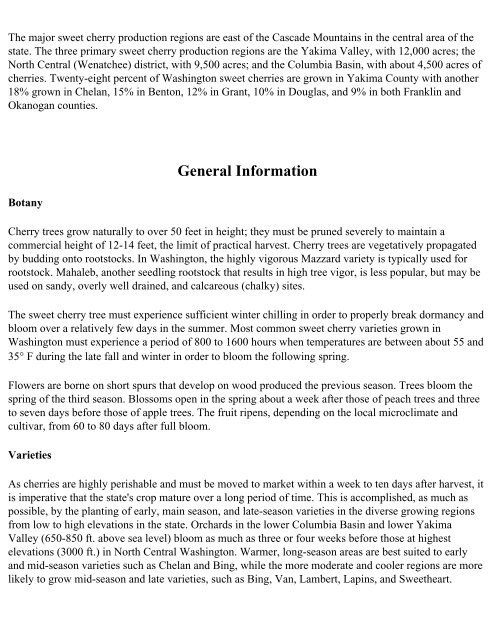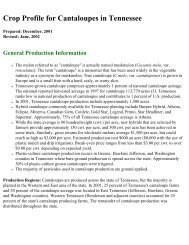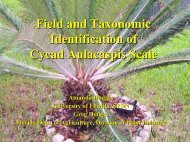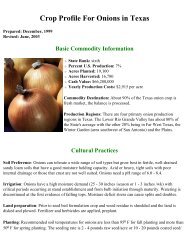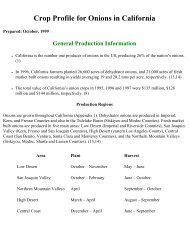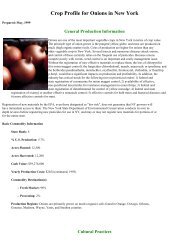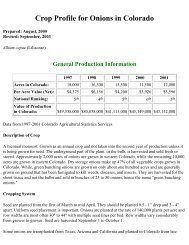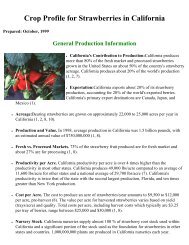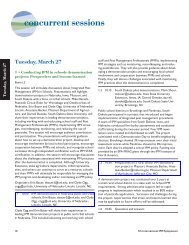Crop Profile for Cherries (Sweet) - Regional IPM Centers
Crop Profile for Cherries (Sweet) - Regional IPM Centers
Crop Profile for Cherries (Sweet) - Regional IPM Centers
Create successful ePaper yourself
Turn your PDF publications into a flip-book with our unique Google optimized e-Paper software.
The major sweet cherry production regions are east of the Cascade Mountains in the central area of the<br />
state. The three primary sweet cherry production regions are the Yakima Valley, with 12,000 acres; the<br />
North Central (Wenatchee) district, with 9,500 acres; and the Columbia Basin, with about 4,500 acres of<br />
cherries. Twenty-eight percent of Washington sweet cherries are grown in Yakima County with another<br />
18% grown in Chelan, 15% in Benton, 12% in Grant, 10% in Douglas, and 9% in both Franklin and<br />
Okanogan counties.<br />
Botany<br />
General In<strong>for</strong>mation<br />
Cherry trees grow naturally to over 50 feet in height; they must be pruned severely to maintain a<br />
commercial height of 12-14 feet, the limit of practical harvest. Cherry trees are vegetatively propagated<br />
by budding onto rootstocks. In Washington, the highly vigorous Mazzard variety is typically used <strong>for</strong><br />
rootstock. Mahaleb, another seedling rootstock that results in high tree vigor, is less popular, but may be<br />
used on sandy, overly well drained, and calcareous (chalky) sites.<br />
The sweet cherry tree must experience sufficient winter chilling in order to properly break dormancy and<br />
bloom over a relatively few days in the summer. Most common sweet cherry varieties grown in<br />
Washington must experience a period of 800 to 1600 hours when temperatures are between about 55 and<br />
35° F during the late fall and winter in order to bloom the following spring.<br />
Flowers are borne on short spurs that develop on wood produced the previous season. Trees bloom the<br />
spring of the third season. Blossoms open in the spring about a week after those of peach trees and three<br />
to seven days be<strong>for</strong>e those of apple trees. The fruit ripens, depending on the local microclimate and<br />
cultivar, from 60 to 80 days after full bloom.<br />
Varieties<br />
As cherries are highly perishable and must be moved to market within a week to ten days after harvest, it<br />
is imperative that the state's crop mature over a long period of time. This is accomplished, as much as<br />
possible, by the planting of early, main season, and late-season varieties in the diverse growing regions<br />
from low to high elevations in the state. Orchards in the lower Columbia Basin and lower Yakima<br />
Valley (650-850 ft. above sea level) bloom as much as three or four weeks be<strong>for</strong>e those at highest<br />
elevations (3000 ft.) in North Central Washington. Warmer, long-season areas are best suited to early<br />
and mid-season varieties such as Chelan and Bing, while the more moderate and cooler regions are more<br />
likely to grow mid-season and late varieties, such as Bing, Van, Lambert, Lapins, and <strong>Sweet</strong>heart.


